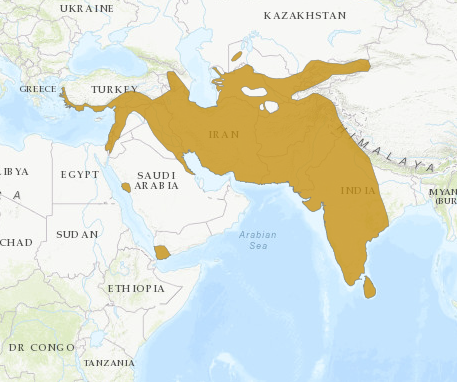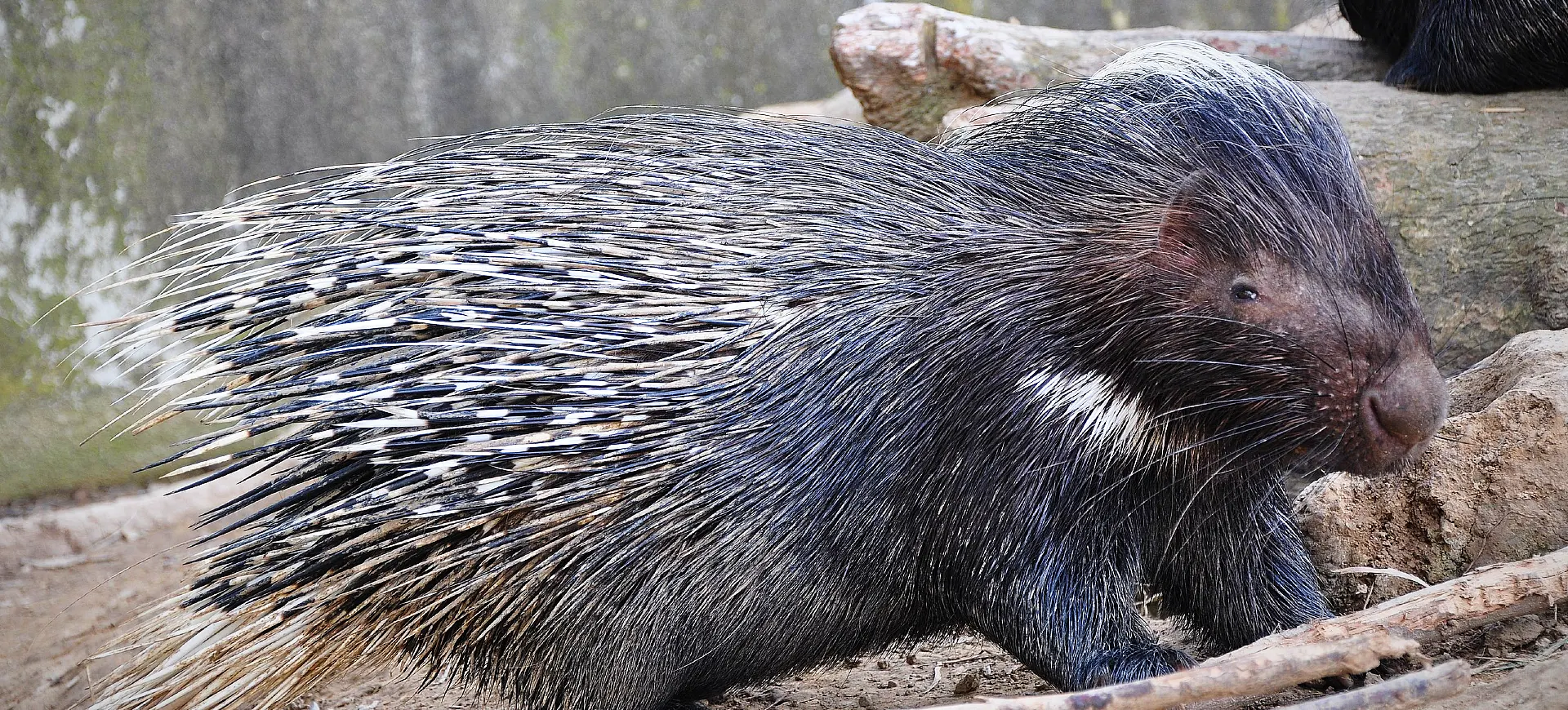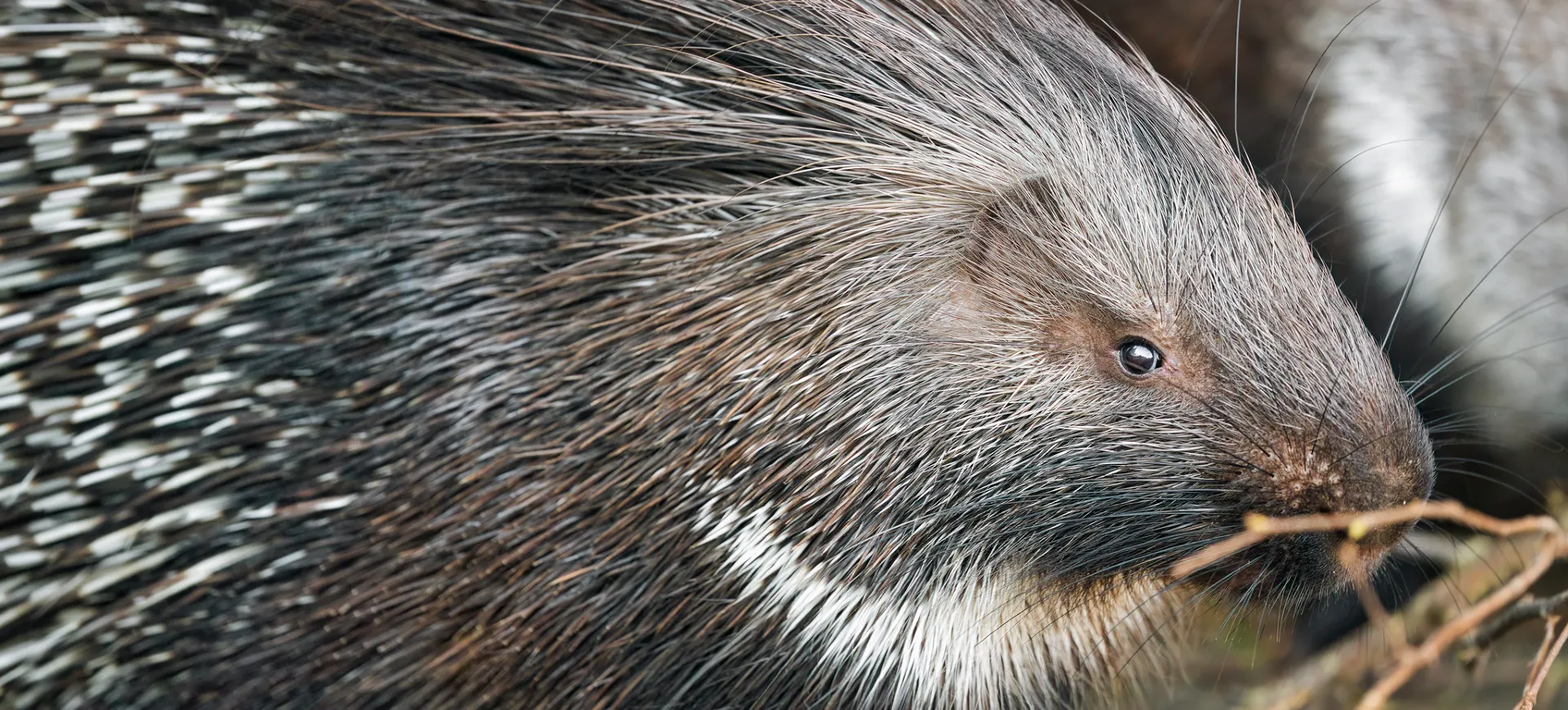Overview
The Indian Crested Porcupine, scientifically known as Hystrix indica, is distinguished by its array of sharp quills, which effectively defend against potential threats. These nocturnal rodents boast a well-built physique, complemented by a characteristic crest of stiff bristles and quills that stand erect in the face of danger. Their capability to thrive in diverse environments, from dense forests and arid deserts to rugged terrains, highlights their remarkable adaptability.
Their diet is exclusively herbivorous, comprising various plant materials such as fruits, grains, roots, and tubers, which they diligently forage at night. This feeding behavior underscores their role as crucial agents in seed dispersal and soil aeration, thanks to their habitual digging. Yet, their preference for cultivated crops often conflicts with farmers, who view them as agricultural pests despite their ecological benefits.
Indian Crested Porcupines are noted for their intriguing social dynamics and intellectual curiosity. They form enduring bonds, especially evident in the monogamous pairs and their interactions with offspring, demonstrating social complexity rarely seen among rodent species. This social fabric, coupled with their intelligence, makes them a captivating focus for research and conservation efforts despite their challenges to human agricultural activities.
Taxonomy
Kingdom
Phylum
Class
Order
Family
Genus
Species
Type
RANGE
Current distribution:
The Indian Crested Porcupine is widely distributed across the Indian subcontinent, extending into Southeast Asia and the Middle East. Their range covers various countries, including India, Nepal, Bhutan, Bangladesh, Sri Lanka, Pakistan, and parts of the Middle East, such as Iran and Turkey. Despite their wide distribution, their presence is more localized in areas that provide suitable habitat conditions, including the availability of food and shelter.
There has been a noticeable expansion in their range in recent years, partly due to their adaptability to human-modified landscapes. However, this expansion has led to increased conflicts with agricultural communities, as these porcupines can cause significant damage to crops and young trees. Despite these challenges, their adaptability and resilience have allowed them to maintain stable populations across much of their range.
Physical Description:
Indian Crested Porcupines have a distinctive appearance marked by their long, thick quills, which are black and white and can reach up to 35 cm long. These quills cover the back and sides of the body, while shorter, softer fur covers the head, legs, and underparts. They possess a short, stubby tail equipped with rattling quills that serve as a warning device when threatened. The porcupine’s face is characterized by small eyes, a blunt snout, and strong, chisel-like teeth continuously growing throughout life.
Adult Indian Crested Porcupines have a body length ranging from 70 to 90 cm, not including their short tail, which adds 8 to 10 cm. They are one of the larger porcupine species, with weights varying significantly from 11 to 18 kg depending on their habitat and diet. Their physical adaptations, including powerful claws and a strong build, enable them to dig extensive burrow systems. These caves are crucial for their shelter, protection from predators, and raising their young.

Lifespan: Wild: ~12 Years || Captivity: ~20 Years

Weight: Male & Female: 20-29 lbs (9-13 kg)

Length: Male & Female: 27-35 in (70-90 cm)

Top Speed: 15 mph (24 km/h)
Characteristic:
Native Habitat:
The Indian Crested Porcupine inhabits many environments, from arid deserts to dense forests. It is highly adaptable and can be found in various terrains, including rocky outcrops, hillsides, and agricultural areas. This adaptability to different habitats is attributed to its dietary flexibility and burrowing habits, which provide it with shelter and protection across these diverse settings.
These porcupines prefer habitats that offer ample food sources and shelter. They are known to inhabit altitudes up to 2400 meters, indicating their capability to adapt to various climatic conditions. The burrows they construct are complex, with multiple entrances and chambers, serving as a haven from predators and extreme weather conditions.
Biomes:
Biogeographical Realms:
Continents:
Countries:
Diet:
Diet & Feeding Habits:
Indian Crested Porcupines are herbivores with a diet of various plant materials. They feed on leaves, fruits, and grains and can often be found foraging for roots, tubers, and bark, which they are particularly fond of. These porcupines strongly prefer cultivated crops and can cause significant agricultural damage, which is why they are considered pests in many regions.
Despite their destructive feeding habits, Indian Crested Porcupines play an essential role in their ecosystems. Their foraging behavior aids in seed dispersal and the aeration of soil, contributing to ecological health and vegetation regeneration. They have adapted to consume a wide range of vegetation, allowing them to thrive in diverse habitats. Their specialized gut microbiome facilitates their ability to digest tough plant material, which helps break down fibrous content.
Mating Behavior:
Mating Description:
Indian Crested Porcupines are monogamous, forming long-term pair bonds with their mates. These bonds are strengthened through mutual grooming, shared burrow use, and cooperative care of their offspring. Mating can occur throughout the year, but peaks in breeding activity are observed during the spring and autumn.
Females give birth to one to four young after a gestation period of approximately 240 days. The offspring, known as porcupines, are born with soft quills that harden within a few hours after birth. Parental care is highly developed in this species, with both parents participating in nurturing and protecting their young. The porcupines are weaned around two months of age but may stay with their family group for an extended period before becoming independent.
Reproduction Season:
Birth Type:
Pregnancy Duration:
Female Name:
Male Name:
Baby Name:
Social Structure Description:
Indian Crested Porcupines exhibit a social structure that is somewhat unique among rodents. They are characterized by their monogamous pairing and family groups. These family units consist of a mated pair and their offspring, who may remain with the parents for an extended period before dispersing to establish their own territories. Such social bonds play a crucial role in their survival, providing increased protection against predators and aiding in the care and upbringing of the young.
Within their burrows, which serve as the center of their social life, these porcupines demonstrate a complex range of behaviors, including communication through various vocalizations and body language. The maintenance and defense of these caves are a group effort, showcasing their cooperative nature. Despite their social inclinations, Indian Crested Porcupines are known to exhibit territorial behavior, defending their burrow systems aggressively if threatened.
Groups:
Conservation Status:
Population Trend:
The population of the Indian Crested Porcupine is considered stable across much of its range, thanks to its adaptability to various habitats and dietary flexibility. Despite facing threats from habitat destruction and hunting in some areas, these porcupines have shown resilience and an ability to thrive in human-altered landscapes. Their wide distribution and ability to live near agricultural areas have helped maintain their numbers, even as they conflict with farming communities.
Conservation efforts have not been specifically targeted at the Indian Crested Porcupine due to its Least Concern status and stable population trend. However, preserving their natural habitats and mitigating human-wildlife conflicts are essential for long-term survival. Educating farmers on non-lethal methods of deterring porcupines from crops can help reduce negative interactions and promote coexistence.
Population Threats:
The main threats to the Indian Crested Porcupine include habitat destruction due to agricultural expansion, deforestation, and urbanization. These activities can lead to the loss of their natural habitats and food sources, which impacts their survival. Additionally, in some regions, they are hunted for their meat and quills, which directly threatens their population.
Conflict with humans, particularly farmers, is another significant challenge for the Indian Crested Porcupine. Their feeding habits can cause substantial damage to crops and young trees, leading to attempts at eradication through hunting or poisoning. These conflicts highlight the need for effective human-wildlife conflict management strategies to protect both agricultural interests and porcupine populations.
Conservation Efforts:
Conservation efforts for the Indian Crested Porcupine are generally focused on habitat preservation and managing human-wildlife conflicts. Protecting and restoring their natural habitats can help ensure the availability of food and shelter, supporting stable populations. Initiatives to educate farmers on non-lethal deterrents and the ecological benefits of porcupines can also contribute to reducing conflicts and fostering coexistence.
In some areas, wildlife corridors and protected areas have been established to secure habitats for wildlife, including the Indian Crested Porcupine. These efforts benefit porcupines and a wide range of other species, promoting biodiversity and ecological health. Ongoing research into their ecology and behavior can further inform conservation strategies, ensuring the Indian Crested Porcupine remains a thriving part of its ecosystem.
Additional Resources:
Fun Facts
- The quills of the Indian Crested Porcupine can be up to 35 cm long and are used as an effective defense mechanism against predators.
- They can make a wide range of sounds, from grunts and whines to loud shrieks used for communication.
- Indian Crested Porcupines have a unique ability to rattle their hollow quills, creating a warning sound to deter predators.
- These porcupines are excellent swimmers, although they prefer to stay on land.
- They have an extraordinary memory for locating food sources and can travel long distances to revisit a feeding site.
- Humans have used their quills in various cultures for decorative purposes and traditional medicine.
- Indian Crested Porcupines are among the few animals that can digest toxic plant materials, thanks to specialized gut bacteria.
- They can live for up to 20 years in captivity, which is significantly longer than the lives of many other rodent species.
- The porcupine’s quills are soft at birth but harden within a few hours, providing them with immediate protection.
- These porcupines are known to gnaw on bones to obtain minerals like calcium, aiding quill development.











